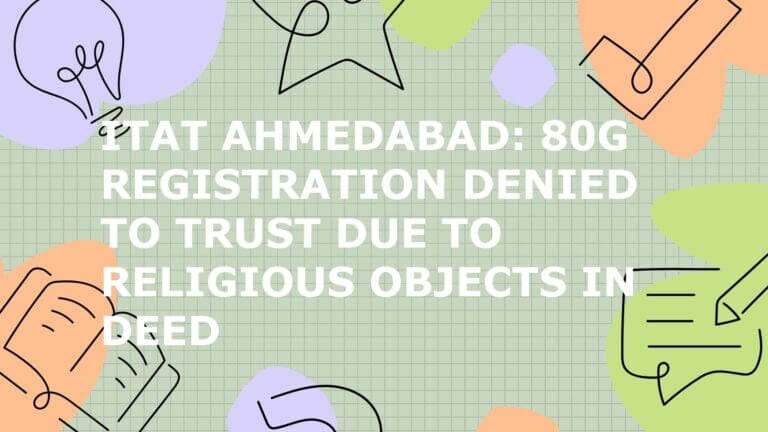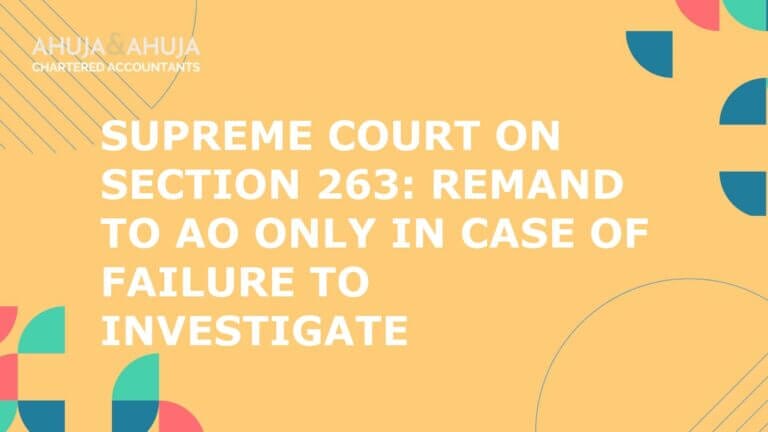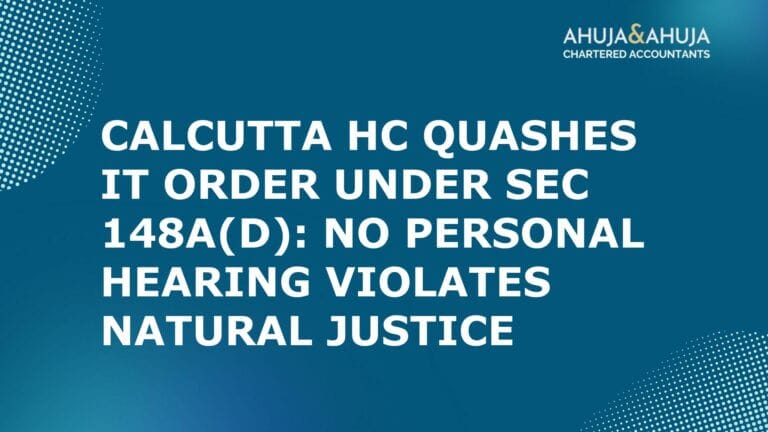ITAT Delhi: No Income Tax Addition on Unsubstantiated WhatsApp Chats Between Employees
The digital age has transformed how businesses communicate, with WhatsApp, emails, and other messaging platforms now woven into daily operations. This shift has not gone unnoticed by tax authorities, who increasingly rely on digital trails during investigations. But how much weight should be given to informal chats when it comes to serious tax additions? The recent ruling by the Income Tax Appellate Tribunal (ITAT Delhi) in Designers Point (India) Pvt. Ltd. vs ACIT throws sharp light on this question, setting a significant precedent for both businesses and tax professionals.
The Dispute: WhatsApp Chats at the Heart of a Tax Addition
The case involved Designers Point (India) Pvt. Ltd., a Delhi-based company, and the Assessing Officer (AO) from the Income Tax Department. During a search and seizure operation, the AO found WhatsApp conversations between two employees, Ms. Seema Dutta and Mr. Aman Sehgal, allegedly discussing part salary payments in cash. Supplemented by their statements, the AO made an addition of Rs. 5,75,000 under Section 69C of the Income Tax Act, treating it as unexplained expenditure.
The company challenged this addition, arguing that WhatsApp chats, without corroborative evidence, cannot be the sole basis for such a serious tax adjustment. The matter escalated through the Commissioner of Income Tax (Appeals) [CIT(A)] and finally landed before the ITAT Delhi.
Legal Grounds for Rejecting WhatsApp Chats as Evidence
Section 69C deals with unexplained expenditure, allowing the tax department to add back any spending for which the source cannot be satisfactorily explained. However, the law also demands a certain standard of proof. The ITAT Delhi, in its detailed order, made it clear that:
- Digital chats, by themselves, lack probative value unless properly authenticated and corroborated.
- The tribunal referenced settled law on the admissibility of electronic evidence, noting that WhatsApp messages can be easily manipulated, lack official authentication, and do not inherently prove the facts asserted within them.
- In this case, there was no technical verification, no digital signature, and no independent confirmation linking the chats to actual cash payments.
The tribunal emphasised that mere reliance on WhatsApp conversations, without more, does not meet the evidentiary threshold required for additions under Section 69C.
The Missing Link: Corroborative Documentary Evidence
A key factor in the tribunal’s decision was the absence of any supporting documentary evidence. The AO had not produced:
- Payroll records showing cash withdrawals or unaccounted salary payments,
- Bank statements reflecting unexplained outflows,
- Any seized documents or audit trails substantiating the claims made in the chats.
The tribunal pointed out that, in the absence of such corroboration, the WhatsApp chats and employee statements stood on shaky ground. Interestingly, the CIT(A) had already deleted similar additions for two other employees (Shri Dhananjay Singh and Ms. Yamini Singh) due to lack of evidence, yet confirmed the addition for Ms. Dutta and Mr. Sehgal on the same weak basis—a distinction the ITAT found unsustainable.
The Right to Cross-Examination: A Cornerstone of Fairness
Another procedural lapse highlighted by the ITAT was the denial of cross-examination. The company had specifically requested the opportunity to cross-examine the employees whose statements were being used against it. This request was not granted. The tribunal reaffirmed that:
- The right to cross-examination is fundamental in tax proceedings when statements are relied upon for adverse findings.
- Denial of this right undermines the fairness and legality of the assessment, further eroding the evidentiary value of the statements.
The ITAT Delhi’s decision in Designers Point vs ACIT is more than just a technical win for one taxpayer—it’s a landmark in how digital communications are treated in tax proceedings. Let’s unpack the wider impact, practical lessons, and the evolving boundaries for digital evidence in Indian tax law.
Precedent for Digital Communications in Tax Assessments
This ruling sends a clear message: WhatsApp chats, emails, or SMS cannot be treated as conclusive evidence for tax additions unless they are properly authenticated and corroborated. The tribunal’s approach sets a reference point for future assessments, compelling tax authorities to:
- Avoid relying solely on informal digital exchanges.
- Seek supporting material—such as financial records, audit trails, or third-party confirmations—before making additions.
- Recognise that digital messages, by their very nature, are susceptible to manipulation and lack inherent reliability unless verified.
Scope and Limitations:
While this case strengthens the defence against unsubstantiated digital evidence, it does not mean all digital communications are inadmissible. The ruling applies most strongly where chats are unverified, lack context, and are unsupported by other evidence.
Practical Takeaways for Businesses: Salary Documentation & Compliance
For businesses, the message is straightforward:
- Maintain robust payroll records. Ensure all salary payments—whether by bank transfer or cash—are properly documented, with clear audit trails.
- Avoid informal arrangements. Relying on WhatsApp or verbal agreements for sensitive matters like salary can create unnecessary risk.
- Respond promptly to tax queries. If questioned, be ready to produce appointment letters, salary slips, bank statements, and any other relevant documentation.
DOs:
- Keep digital and physical records aligned.
- Regularly audit HR and payroll processes.
- Train staff on the importance of formal documentation.
DON’Ts:
- Don’t treat informal chats as substitutes for official records.
- Don’t ignore requests for cross-examination or procedural fairness.
To learn more about payroll management and tax compliance, you can explore our payroll outsourcing services which help maintain accurate salary records and ensure regulatory compliance.
Strategic Guidance for Tax Professionals
Tax professionals should take note of the defensive strategies validated by this case:
- Challenge additions based on weak digital evidence. Insist on authentication, context, and corroboration.
- Highlight procedural lapses. If cross-examination is denied or evidence is not shared, raise these issues forcefully.
- Advise clients on evidence retention. Encourage systematic record-keeping and proactive compliance to pre-empt disputes.
Dispelling Myths: Are Digital Chats “Conclusive” Evidence?
A common misconception is that digital chats, once found, are “smoking gun” evidence. This case clarifies:
- Chats are not conclusive unless authenticated and corroborated.
- The context, intent, and linkage to actual transactions must be established.
- Courts and tribunals will scrutinise the reliability and integrity of digital evidence, not just its existence.
For detailed understanding of electronic evidence and related procedures, see our blog on Calcutta HC Quashes IT Order under Sec 148A(d): No Personal Hearing Violates Natural Justice.
When Can Digital Chats Be Admitted as Evidence?
There are scenarios where digital communications may be valid evidence, but only if:
- Proper authentication is established (e.g., through digital signatures, forensic analysis, or confirmation from both parties).
- Corroborative evidence exists—such as matching bank entries, accounting records, or third-party confirmations.
- Audit trails and metadata support the genuineness and context of the chats.
Judicial expectations are clear: Reliability, integrity, and linkage to the facts in dispute are essential.
Alignment with Broader Legal Framework & Case Law
The ITAT’s approach aligns with the Indian Evidence Act and the Information Technology Act, which set out requirements for the admissibility of electronic records. Previous case law has also emphasised:
- The need for proper certification and authentication of digital evidence (see Section 65B of the Evidence Act).
- The principle that untested or uncorroborated electronic evidence carries little weight.
This ruling fits squarely within that framework, reinforcing the need for rigour and fairness.
For an overview of related income tax litigation services, our income-tax litigation page provides practical support for navigating disputes.
Procedural Safeguards: Best Practices for All
For Businesses:
- Implement internal controls for salary and HR documentation.
- Maintain clear digital trails and back up key records.
- Ensure all employee communications on sensitive matters are formalised.
For Tax Authorities:
- Offer cross-examination when relying on employee statements.
- Seek corroborative evidence before making additions.
- Ensure transparency and fairness in assessment proceedings.
For professional advice in the Delhi jurisdiction, we also invite you to visit our Delhi Chartered Accountants page for more details about local services and expertise.
Final Word: Balancing Innovation and Due Process
The Designers Point ruling is a timely reminder that while tax investigations must keep pace with the digital era, the fundamentals of evidence and fairness remain unchanged. Digital innovation cannot come at the cost of procedural rigour or the rights of taxpayers.
Key takeaway:
In the digital age, only evidence that is reliable, corroborated, and fairly tested will stand up to scrutiny. Businesses and tax professionals should treat documentation and procedural safeguards as non-negotiable pillars of compliance.
Disclaimer
The materials provided herein are solely for educational and informational purposes. No attorney/professional-client relationship is created when you access or use the site or the materials. The information presented on this site does not constitute legal or professional advice and should not be relied upon for such purposes or used as a substitute for professional or legal advice.







